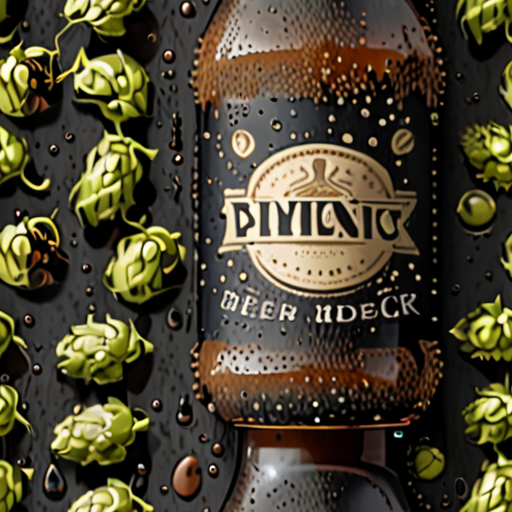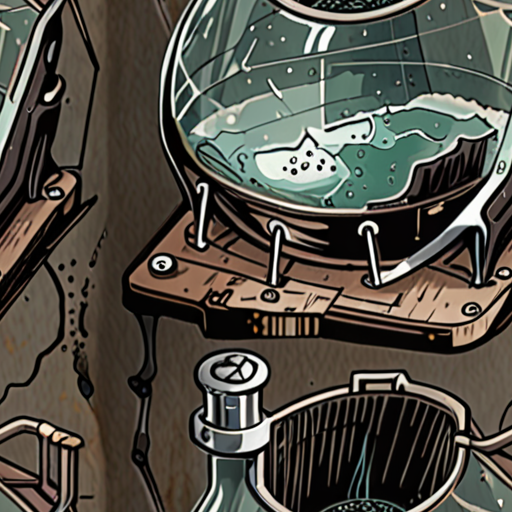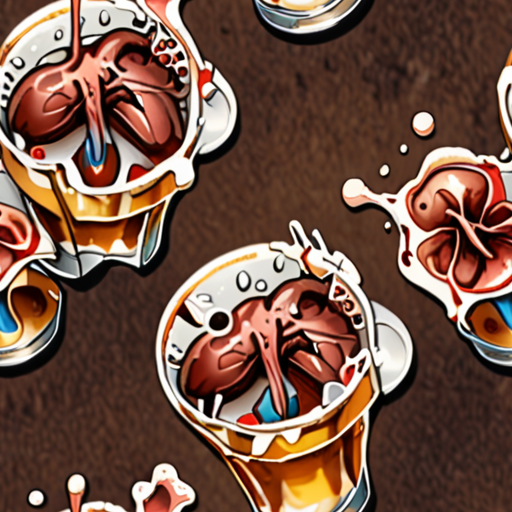When it comes to enjoying a cold beer, there’s nothing quite like the taste and experience of a perfectly brewed pint. However, even the most skilled brewers can fall victim to beer defects, which can range from off-flavors and aromas to more serious issues like contamination and spoilage.

Four Common Problems with Beer
Breweries strive to produce high-quality beers, but sometimes issues can arise during the brewing process.
- Bacterial Spoilage
- Ingredient Variation
- Haze
- Improper Carbonation Level
This is perhaps the most feared problem in beer production, especially for non-pasteurizing breweries. Bacterial contamination can occur due to poor sanitation, inadequate equipment cleaning, or contaminated ingredients.
Ingredients play a crucial role in determining the flavor and quality of beer. Variations in ingredient quality, quantity, or type can affect the final product’s taste, aroma, and overall character.
Haze in beer can be caused by several factors, including poor filtration, incorrect storage conditions, or the presence of particles. Haze can negatively impact the appearance and overall drinking experience of beer.
Carbonation is essential for beer’s refreshing quality and mouthfeel. However, improper carbonation levels can result in flat or over-carbonated beers, affecting the drinker’s enjoyment.
At The Goods On Tap , we understand the importance of producing high-quality beers. Our team of experts is committed to helping breweries overcome these common problems and deliver exceptional beers to our customers.
We recommend checking out our brewery reviews section for in-depth analysis of various breweries and their products. Additionally, our beer trends page provides valuable insights into the latest developments in the craft beer industry.
For more information on beer production and quality control, visit the Brewers Association website, which offers a wealth of knowledge and resources for brewers and beer enthusiasts alike.
What is Beer Syndrome?
Beer syndrome, also known as AutoBrewery Syndrome or Gut Fermentation Syndrome, is a rare disorder characterized by the endogenous production of alcohol.
- The condition typically presents with symptoms of alcohol intoxication, including staggering gait, slurred speech, gastrointestinal distress, and a state of confusion.
- Individuals with beer syndrome may experience these symptoms even when they have not consumed any external sources of alcohol.
Causes and Risk Factors:
The exact causes of beer syndrome are still not fully understood, but several factors can contribute to its development.
- A high-carbohydrate diet can lead to an overgrowth of yeast in the gut, which can ferment carbohydrates and produce ethanol.
- Underlying medical conditions, such as diabetes, liver disease, or gastrointestinal disorders, can increase the risk of developing beer syndrome.
- Medications, such as antibiotics or antifungals, can disrupt the balance of gut bacteria and contribute to the development of beer syndrome.
Symptoms and Diagnosis:
The symptoms of beer syndrome can vary widely depending on the individual and the severity of the condition.
- Common symptoms include:
- Staggering gait or loss of coordination
- Slurred speech or difficulty speaking
- Gastrointestinal distress, such as nausea or vomiting
- Confusion or disorientation
- Headaches or dizziness
Treatment and Management:
The treatment for beer syndrome typically involves addressing the underlying cause of the condition and managing symptoms.
- Antibiotics or antifungals may be prescribed to treat underlying infections or yeast overgrowth.
- Dietary changes, such as reducing carbohydrate intake or avoiding fermented foods, may help alleviate symptoms.
- Supportive care, such as hydration and rest, may be necessary to manage symptoms and prevent complications.
Prevention and Prognosis:
While there is no guaranteed way to prevent beer syndrome, certain lifestyle modifications can reduce the risk of developing the condition.
- Eating a balanced diet that includes plenty of fruits, vegetables, and whole grains can help support gut health.
- Regular exercise and stress management can also help reduce the risk of developing beer syndrome.
- Early diagnosis and treatment can significantly improve outcomes and prevent long-term complications.

Understanding Faulty Beer
A beer fault or defect is a flavor deterioration caused by chemical changes of organic compounds in beer due to either improper production processes or improper storage.
- Chemicals that can cause flavor defects in beer are aldehydes such as dactyl, organic acids, lipids, and sulfur compounds.
- These chemicals can arise from various factors, including contamination during brewing, inadequate sanitation, or poor storage conditions.
- Faulty beer can exhibit off-flavors, aromas, or textures that detract from its overall quality and appeal.
Common Causes of Faulty Beer
The causes of faulty beer can be attributed to several factors, including:
- Inadequate brewing techniques or equipment maintenance
- Contamination during fermentation or packaging
- Poor storage conditions, such as exposure to light, heat, or oxygen
- Incorrect handling or transportation procedures
Identifying and Addressing Faulty Beer
To identify and address faulty beer, brewers and consumers alike can take the following steps:
- Monitor beer quality through regular sensory evaluations and laboratory testing
- Implement proper brewing and packaging procedures to minimize contamination risks
- Store beer in optimal conditions, such as cool temperatures and minimal light exposure
- Handle and transport beer with care to prevent damage or contamination
Preventing Faulty Beer
Preventing faulty beer requires attention to detail and adherence to best practices in brewing, packaging, and storage.
- Maintain clean and sanitized equipment to prevent contamination
- Follow established brewing protocols to ensure consistent quality
- Store beer in a controlled environment to preserve its integrity
- Train staff on proper handling and transportation procedures
Conclusion
By understanding the causes of faulty beer and taking proactive measures to prevent it, brewers and consumers can enjoy high-quality beers that meet their expectations.

The Most Unhealthy Beer
We’ve analyzed numerous beers to determine which one takes the title of the most unhealthy.
- Bud Light Chelada
- Shock Top Belgian White
- Miller High Life
- Natty Light
- Coors Banquet
This beer has a whopping 138 calories per serving, making it one of the highest-calorie beers available. With its high sugar content and lack of nutritional benefits, it’s easy to see why it tops our list.
This beer contains 170 calories per serving and boasts a significant amount of carbohydrates. While it may taste refreshing, its high calorie count makes it a less-than-ideal choice for those watching their diet.
Made with corn syrup and rice, Miller High Life packs a punch with 145 calories per serving. Its high sugar content and low nutritional value earn it a spot on our list of unhealthy beers.
This budget-friendly beer clocks in at 95 calories per serving, but don’t let that fool you – it still contains a significant amount of carbs and lacks essential nutrients. Its popularity among college students and partygoers doesn’t make it any healthier, unfortunately.
With 144 calories per serving, Coors Banquet rounds out our list of unhealthy beers. Its high carbohydrate content and lack of nutritional benefits make it a less-than-desirable choice for health-conscious drinkers.
When choosing a beer, consider opting for lower-calorie options or trying a craft beer with more nutritional benefits. Remember, moderation is key when it comes to enjoying your favorite brews.
Will 6 beers a day cause liver damage?
The impact of consuming six beers per day on liver health is a pressing concern for many individuals who enjoy moderate drinking.
- Liver damage can occur due to excessive alcohol consumption, which may lead to conditions such as alcoholic hepatitis, fibrosis, and cirrhosis.
- A study published in the Journal of Clinical Gastroenterology found that heavy drinkers who consumed more than five drinks per day had a significantly increased risk of developing liver disease compared to those who drank less frequently.
Risks associated with daily beer consumption:
- Fatty liver disease: Consuming high amounts of alcohol can lead to the accumulation of fat in liver cells, causing inflammation and potentially leading to scarring.
- Cirrhosis: Prolonged exposure to toxic substances, including ethanol, can cause irreversible scarring of the liver tissue, impairing its ability to function properly.
- Hepatitis: Inflammation of the liver caused by viral infections, toxins, or autoimmune disorders can be exacerbated by excessive drinking.
Factors influencing individual susceptibility:
- Genetic predisposition: Some people may be more susceptible to liver damage due to genetic factors, such as variations in the ALDH2 gene.
- Age: Older adults may be more vulnerable to liver damage due to decreased liver function and increased sensitivity to toxins.
- Pre-existing medical conditions: Certain health conditions, such as diabetes, obesity, and hypertension, can increase the risk of liver damage.
Reducing the risk of liver damage:
- Drink responsibly: Limit daily beer consumption to moderate levels (one drink per day for women and two drinks per day for men).
- Eat a balanced diet: Include foods rich in antioxidants, fiber, and omega-3 fatty acids to support liver health.
- Exercise regularly: Engage in physical activity to promote overall well-being and reduce the risk of chronic diseases.

What is the Healthiest Beer to Drink?
The quest for the healthiest beer can be a daunting task, especially with the numerous options available in the market.
- Brewed with wholesome ingredients
- Low calorie count
- No artificial additives
- High antioxidant levels
Key Factors to Consider
-
Ingredients:
- Choose beers made with whole grains, fruits, and herbs
- Avoid beers containing high-fructose corn syrup and artificial preservatives
-
Nutritional Content:
- Opt for low-calorie beers (<50 calories per serving)
- Select beers with minimal sugar content
-
Antioxidant Levels:
- Look for beers brewed with hops rich in antioxidants
- Consider beers infused with fruits and herbs high in antioxidants
Top Picks for Healthy Beers
-
New Belgium Fat Tire Amber Ale
- Made with whole grains and hops
- Low calorie count (170 calories per serving)
-
Sam Adams Light Lager
- Low calorie count (119 calories per serving)
- No artificial additives or preservatives
-
Shock Top Belgian White
- Made with whole grains and citrus peels
- High antioxidant levels due to citrus peels
Conclusion
In conclusion, finding the healthiest beer involves considering factors such as ingredients, nutritional content, and antioxidant levels.
By choosing beers made with wholesome ingredients, low in calories, and rich in antioxidants, you can enjoy a healthier drinking experience.
Remember to always check the labels and look for certifications like USDA Organic or Non-GMO to ensure you’re getting a healthy brew.

0 Comments